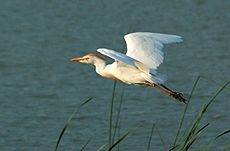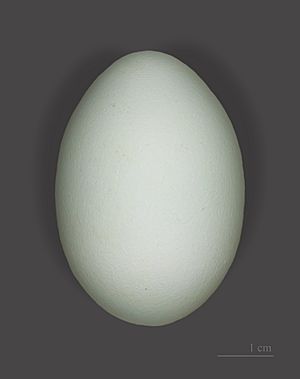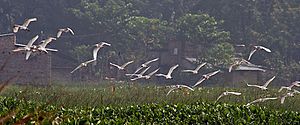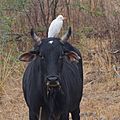Cattle Egret facts for kids
Quick facts for kids Cattle Egret |
|
|---|---|
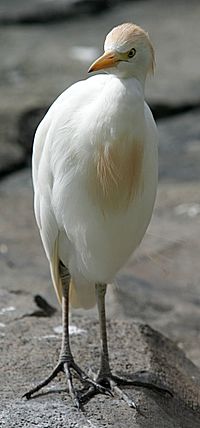 |
|
| Breeding adult | |
| Conservation status | |
| Scientific classification | |
| Kingdom: | |
| Phylum: | |
| Class: | |
| Order: | |
| Family: | |
| Genus: |
Bubulcus
Bonaparte, 1855
|
| Species: |
B. ibis
|
| Binomial name | |
| Bubulcus ibis (Linnaeus, 1758)
|
|
| Subspecies | |
|
B. i. ibis (Linnaeus, 1758) |
|
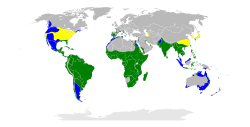 |
|
| Range map yellow: breeding green: year-round blue: non-breeding |
|
| Synonyms | |
|
Ardea ibis Linnaeus, 1758 |
|
The Cattle Egret (Bubulcus ibis) is a type of heron found all over the world. You can spot them in warm places like the tropics and subtropics. They are the only bird in their group, called Bubulcus.
Cattle Egrets are sturdy white birds. During their breeding season, they get pretty buff-colored feathers. They build their nests in large groups, often near water, with other wading birds.
Unlike most herons, Cattle Egrets like to find food in dry, grassy areas. They often hang out with cattle or other big animals. They eat insects and small creatures that these animals stir up. They also sometimes pick ticks and flies right off the cattle!
These birds first lived in parts of Asia, Africa, and Europe. But they have spread very quickly around the world. This is because humans now raise farm animals almost everywhere. Some Cattle Egrets travel long distances, while others move to new places after they finish breeding.
Contents
Where Cattle Egrets Live and What They Like
The Cattle Egret has spread its home range faster than almost any other bird. It's a truly amazing story!
These birds originally lived in southern Spain and Portugal. They also lived in warm parts of Africa and humid areas of Asia. In the late 1800s, they started moving into southern Africa. They first nested in South Africa in 1908.
Cattle Egrets Arrive in the Americas
Cattle Egrets were first seen in the Americas in 1877. This was near French Guiana and Suriname. It seems they flew all the way across the Atlantic Ocean! By the 1930s, they had settled down in that area.
The birds first arrived in North America in 1941. They started nesting in Florida in 1953. From there, they spread quickly. By 1962, they were nesting in Canada. Now, you can see them as far west as California. They also started nesting in Cuba in 1957 and Costa Rica in 1958.
Cattle Egrets Return to Europe
In Europe, the number of Cattle Egrets had gone down in Spain and Portugal. But in the late 1900s, they came back. They then began to spread to other parts of Europe. They reached southern France in 1958 and northern France in 1981. They arrived in Italy in 1985.
In 2008, Cattle Egrets nested in the United Kingdom for the first time. This was just a year after many birds arrived there. In 2008, they were also seen in Ireland for the first time.
Cattle Egrets in Australia and New Zealand
In Australia, the birds started arriving in the 1940s. They settled in the north and east of the country. They began visiting New Zealand regularly in the 1960s.
Since 1948, Cattle Egrets have lived in Israel all year round. Before that, they only visited in winter.
Why They Spread So Much
The huge and fast spread of the Cattle Egret is linked to humans. It's because of our farm animals. These birds used to follow large wild animals to find food. But they easily switched to following cattle and horses. As people raised more livestock around the world, the egrets found new places to live and find food.
What Cattle Egrets Eat
Cattle Egrets eat many different kinds of food. They especially love insects. This includes grasshoppers, crickets, flies (both adults and their young), and moths. They also eat spiders, frogs, and earthworms.
These birds are usually seen with cattle or other big animals that eat grass. They catch small creatures that the mammals scare up. Studies show that Cattle Egrets find much more food when they are near a large animal. They are 3.6 times better at catching food when with cattle than when alone. They also do well following farm machines.
Images for kids
-
A non-breeding adult eating a frog in the Gambia.
-
A Cattle Egret waiting for food at a fish market in Victoria, Seychelles.
-
A flock of Cattle Egrets in a tree in Minas Gerais, Brazil.
-
A young Cattle Egret on Maui (notice its black beak).
See also
 In Spanish: Bubulcus ibis para niños
In Spanish: Bubulcus ibis para niños



